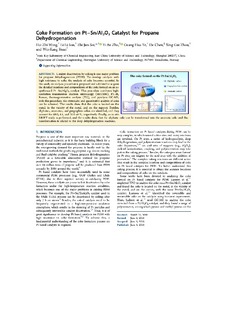Coke Formation on Pt–Sn/Al2O3 Catalyst for Propane Dehydrogenation
| dc.contributor.author | Wang, Haizhi | |
| dc.contributor.author | Sun, Lili | |
| dc.contributor.author | Sui, Zhi Jun | |
| dc.contributor.author | Zhu, Yi-an | |
| dc.contributor.author | Ye, Guanghua | |
| dc.contributor.author | Chen, De | |
| dc.contributor.author | Zhou, Xing-Gui | |
| dc.contributor.author | Yuan, Wei-kang | |
| dc.date.accessioned | 2019-06-03T14:19:14Z | |
| dc.date.available | 2019-06-03T14:19:14Z | |
| dc.date.created | 2018-12-15T17:47:01Z | |
| dc.date.issued | 2018 | |
| dc.identifier.citation | Industrial & Engineering Chemistry Research. 2018, 57 (26), 8647-8654. | nb_NO |
| dc.identifier.issn | 0888-5885 | |
| dc.identifier.uri | http://hdl.handle.net/11250/2599773 | |
| dc.description.abstract | Catalyst deactivation by coking is one major problem for propane dehydrogenation (PDH). To develop catalysts with high resistance to coke, the analysis of coke becomes essential. In this work, an analysis procedure is proposed and validated to acquire the detailed locations and compositions of the coke formed on an as-synthesized Pt–Sn/Al2O3 catalyst. This procedure combines high-resolution transmission electron microscopy (HRTEM), FT-IR, Raman, thermogravimetric analysis (TG), and pyrolysis GC-MS; with this procedure, the systematic and quantitative analysis of coke can be achieved. The results show that the coke is located on the metal, in the vicinity of the metal, and on the support. Besides, aliphatics, aromatics, and pregraphite cokes are identified, and they account for 69.0, 4.4, and 26.6 wt %, respectively. Finally, an in situ DRIFT study is performed, and the results show that the aliphatic coke can be transformed into the aromatic coke and this transformation is related to the deep dehydrogenation reactions. | nb_NO |
| dc.language.iso | eng | nb_NO |
| dc.publisher | American Chemical Society | nb_NO |
| dc.title | Coke Formation on Pt–Sn/Al2O3 Catalyst for Propane Dehydrogenation | nb_NO |
| dc.type | Journal article | nb_NO |
| dc.type | Peer reviewed | nb_NO |
| dc.description.version | acceptedVersion | nb_NO |
| dc.source.pagenumber | 8647-8654 | nb_NO |
| dc.source.volume | 57 | nb_NO |
| dc.source.journal | Industrial & Engineering Chemistry Research | nb_NO |
| dc.source.issue | 26 | nb_NO |
| dc.identifier.doi | 10.1021/acs.iecr.8b01313 | |
| dc.identifier.cristin | 1643685 | |
| dc.description.localcode | © American Chemical Society 2018. This is the authors accepted and refereed manuscript to the article. Locked until 8.6.2019 due to copyright restrictions. | nb_NO |
| cristin.unitcode | 194,66,30,0 | |
| cristin.unitname | Institutt for kjemisk prosessteknologi | |
| cristin.ispublished | true | |
| cristin.fulltext | original | |
| cristin.qualitycode | 2 |
